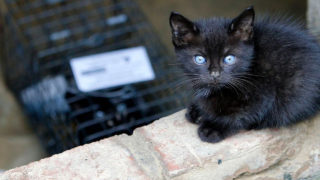More than 85 people joined the guided tours of our Atlantic City Boardwalk Cats Project in Atlantic City, NJ, on July 16. They were introduced to the people and practices that make the Boardwalk Cats Project a model Trap-Neuter-Return (TNR) programand everyone had a blast!
“I couldn’t be more pleased with the turnout and overall success of our recent tours,” said Brianna Lovell, associate director of community engagement & events. “Our team had a wonderful time sharing our story and work with so many attendees. We hope more people now recognize the model of success the project truly is, and feel empowered to take back what they learned to their communities to implement TNR programs of their own.”
There are 89 cats who live under the boardwalk in 15 colonies. The tours highlighted three of these colonies.
First, visitors met Alice Burton, our Associate Director of Animal Shelter & Animal Control Engagement. Alice spoke about the history of the Atlantic City Boardwalk Cats Project and revealed some inside information. For instance, Big Red is the only cat we’ve had to TNR in recent years. He was difficult to get close to at first, so one of our staff members used a wooden drop trap with a cord to release it over him. Although it was heavy, Big Red ran around with the trap on top of him, trying to escapeand he almost made it! He settled down once we were able to cover the trap, and was neutered and returned the next day.
Frank, who is one of 30 volunteers working a combined 160 hours per month providing food, water, and shelter to the Boardwalk Cats, said Big Red is as affectionate as a house cat these days. He loves nuzzling Frank, and has also bonded with Rosie and Mosie, two other cats in his colony. At feeding time, they rub against one another. They’ve become family, and they love their boardwalk home.
At our second stop, Outreach & National Cat Help Desk Specialist Daniel López Breña shared the triumphs and challenges of volunteering for the Boardwalk Cats Project.
Volunteers like Frank really get to know the cats, since they see them every day. Frank said he can pet about 15 of them. In addition to feeding the cats, volunteers look for signs of illness. If they suspect a problem, they’ll text one of the five staff members who support the program on-site so that someone can take a look as soon as possible.
Carefully observing colonies, not only for illness, but for changes is an important aspect of this project. Over time, new colonies can develop while others might dissolve. We recently closed one of our colonies because Sally, the only cat still living there, joined a different colony with more cats.
Our tour ended with Senior Programs Manager & Cat Behavior Expert Matt Wildman showing why the Atlantic City Boardwalk Cats Project is a model for success. Since the program started in 2000, the Boardwalk Cat population has declined naturally by 72 percent. No new litters have been born for years.
Inky, the oldest cat we know of at the boardwalk, is 19. She still eats well and is very healthy. Community cats, like Inky, truly can thrive and lead healthy lives outdoors. And because of Alley Cat Allies, they’re healthier and better cared for.
The Boardwalk Cats Project has brought the Atlantic City community together. During the tours, residents often stopped by to find out what we were up to. Most of them already knew about the Boardwalk Cats and TNR! Locals, shop owners, volunteers, and city government officials all love and care about these cats.
Ripley, a black and white tuxedo cat from our New York Avenue colony, likes to spend his time in a store on the boardwalk called Fashion Island. The owner, Sam, and his wife have a bed for Ripley (who they call Boo Boo) behind the counter and he gets fed in the store. In the winter, they provide a heater for him, and in the summer, they have a fan!
The Atlantic City Boardwalk Cats Project is proof that cats and communities can coexist and thrive when health departments, local animal shelters, volunteers, and nonprofits like Alley Cat Allies work together. Giving these tours, we felt like we were truly a part of something special. Thank you to all who contributed to this experience.

